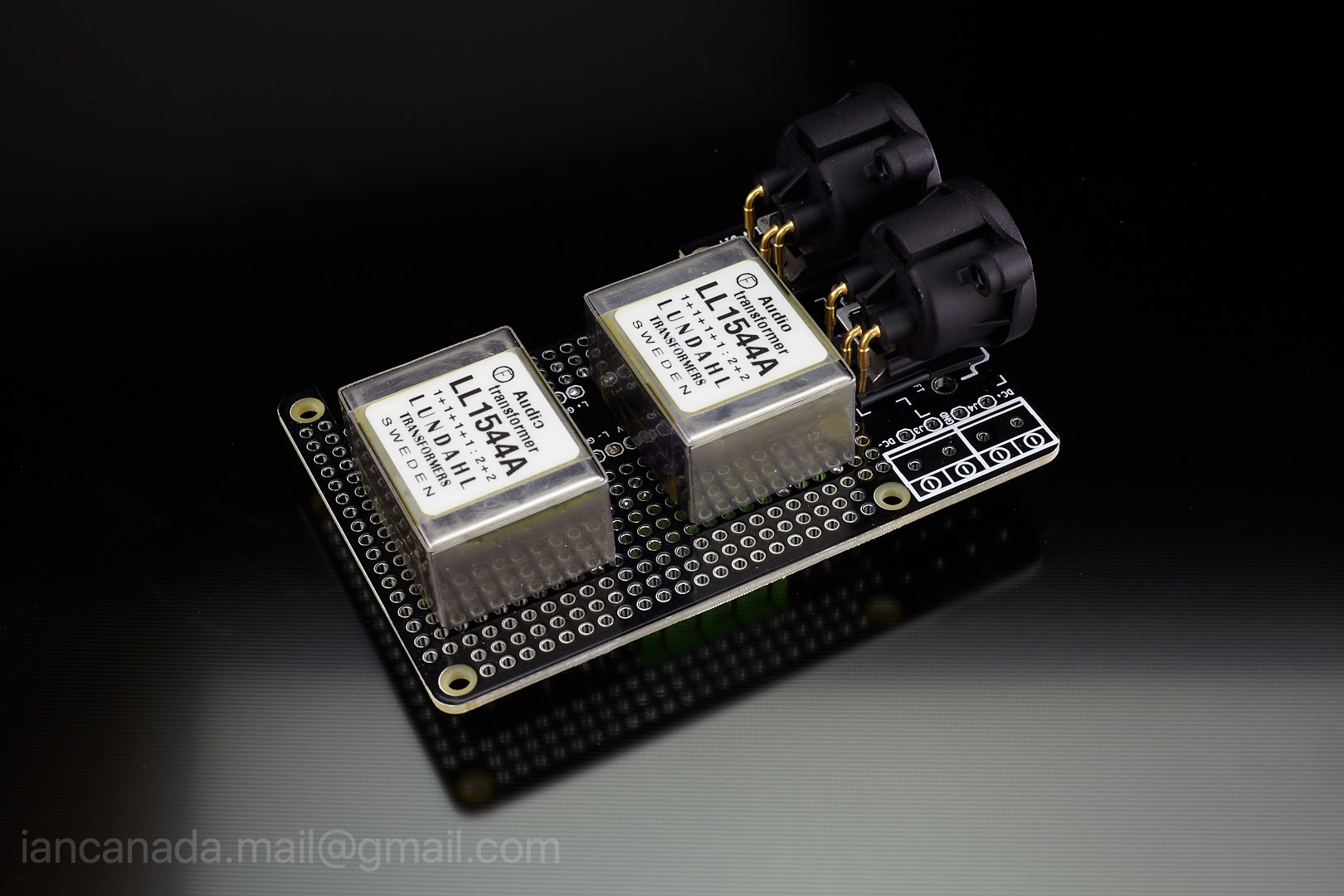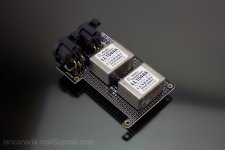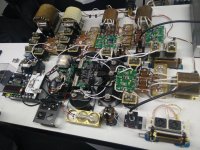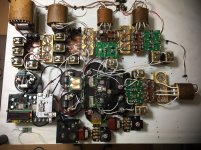LL1544A I/V stage
I built this LL1544A I/V stage on my "hole board". Much compact than the previous LL1674 transformer I/V, looks more suitable for RPi audio application.
It follows madds1's configuration.
http://www.diyaudio.com/forums/pc-b...i2s-dac-hats-raspberry-pi-15.html#post5369598
Please see the attached schematics for details.
Both LL1544A and LL1674 are amorphous core transformer and configured at same input/output ratio, hopefully it has similar sound quality as LL1674.
I'll get LL1544A I/V board compared with other I/V stage HAT very soon. I'll post update after I have test result. If it is promising, I'll design a true adapter PCB. I really like the size and the prices.

LL1544aIV_1 by Ian, on Flickr
Ian
I built this LL1544A I/V stage on my "hole board". Much compact than the previous LL1674 transformer I/V, looks more suitable for RPi audio application.
It follows madds1's configuration.
http://www.diyaudio.com/forums/pc-b...i2s-dac-hats-raspberry-pi-15.html#post5369598
Please see the attached schematics for details.
Both LL1544A and LL1674 are amorphous core transformer and configured at same input/output ratio, hopefully it has similar sound quality as LL1674.
I'll get LL1544A I/V board compared with other I/V stage HAT very soon. I'll post update after I have test result. If it is promising, I'll design a true adapter PCB. I really like the size and the prices.

LL1544aIV_1 by Ian, on Flickr
Ian
Attachments
Last edited:
@EaZy
You would be more likely to get help with your problem by asking on the Volumio Forum.
Thanks. I didn't get help there neither.
I finally switched to Moode, it works flawlessly.
I built this LL1544A I/V stage on my "hole board". Much compact than the previous LL1674 transformer I/V, looks more suitable for RPi audio application.
It follows madds1's configuration.
http://www.diyaudio.com/forums/pc-b...i2s-dac-hats-raspberry-pi-15.html#post5369598
Please see the attached schematics for details.
Both LL1544A and LL1674 are amorphous core transformer and configured at same input/output ratio, hopefully it has similar sound quality as LL1674.
I'll get LL1544A I/V board compared with other I/V stage HAT very soon. I'll post update after I have test result. If it is promising, I'll design a true adapter PCB. I really like the size and the prices.

LL1544aIV_1 by Ian, on Flickr
Ian
Stunning picture 👍
Frank
There was a Thread in which someone described the results saying that it was better than amphorouse core ones. Could not it find for the moment ...
I also experiment with Super v/i ll1684. It is very very good, yet the final performace depands on the cap used. I personally ended up with Jantzen Alumen 8,2uf.
Anyways if the transforer is used the sabre does not work in current but voltage mode right? if so, then figures are worse for voltage mode. How audiobile is that? I do not know.
My best i/v so far is legato v3.1 from twistedpearaudio, which is class A zero global feedback design. Although it is not too crispy like others, it is very meaty, especially in the middle range. I personally love it!
I also experiment with Super v/i ll1684. It is very very good, yet the final performace depands on the cap used. I personally ended up with Jantzen Alumen 8,2uf.
Anyways if the transforer is used the sabre does not work in current but voltage mode right? if so, then figures are worse for voltage mode. How audiobile is that? I do not know.
My best i/v so far is legato v3.1 from twistedpearaudio, which is class A zero global feedback design. Although it is not too crispy like others, it is very meaty, especially in the middle range. I personally love it!
Last edited:
@TioFrancotirador
Not yet, do you have any link to the review?
Ian
Ian and Mirek
Certainly on this PCで音楽
after translation
The Finemet transformers are what Chiaki & Bunpei have moved to for their personal implementations of their SDTran384 with a Chiaki-designed ESS-based DAC, using the various power, chokes, and output transformers from the Finemet line. Attached pictures shows a couple of shots of different versions of their implementation as-of awhile back.
You can see some of the line for sale on EBay US here:
fulken | eBay
Not sure the output transformers they list will fit within the confines of an RPi HAT!
Greg in Mississippi
P.S. the brass blocks with the 3 circular depressions are 3-section Evans Hybrid Capacitors which they have opened and are using each section separately. Also notice the DuCoLon clock! There is some significant financial investment in this setup!
You can see some of the line for sale on EBay US here:
fulken | eBay
Not sure the output transformers they list will fit within the confines of an RPi HAT!
Greg in Mississippi
P.S. the brass blocks with the 3 circular depressions are 3-section Evans Hybrid Capacitors which they have opened and are using each section separately. Also notice the DuCoLon clock! There is some significant financial investment in this setup!
Attachments
Last edited:
Maybe Dibao transformers also could be a good option. They have Lundahl counterparts which seem to perform better.
1+1:1+1?????????-DB1736_???|transformer-??,???????
https://fsdibao.kuaizhan.com/91/86/p3260961360d80e
On TaoBao:
迪寶DB1736 可替代Lundahl LL1527的音頻信號變壓器 頻響出衆
On Alibaba:
1:1 audio output transformer, View audio output transformer, Dibao Product Details from Foshan Nanhai Dibao Electric Factory on Alibaba.com
1+1:1+1?????????-DB1736_???|transformer-??,???????
https://fsdibao.kuaizhan.com/91/86/p3260961360d80e
On TaoBao:
迪寶DB1736 可替代Lundahl LL1527的音頻信號變壓器 頻響出衆
On Alibaba:
1:1 audio output transformer, View audio output transformer, Dibao Product Details from Foshan Nanhai Dibao Electric Factory on Alibaba.com
*Flamesuit on* Lol
Please don’t hate on me for this post.
The whole current vs voltage mode discussion IMHO seems full of contradictions. Maybe I’m wrong here but here’s what I’ve seen over the years...
As soon as people bring out the measuring equipment, current out mode gets put in the spotlight and “proclaimed as the best”. But rarely (if ever) have I seen people claiming sonic superiority.
If anything I’ve seen people saying they like the voltage mode sound better, even if it doesn’t measure as well. A very rough extremely simplified summation seems to indicate that a lot of people describes the sound as more meaty, natural and musical.
I seem to remember there was a pretty serious study made on sound levels and “masking”. Supposedly the human hearing looses the ability to pick up sounds 75db lower than the peak level sound.
So, how important is a number saying -126db vs -136db?
Same thing goes for frequency range and the number of bits, at what point will diminishing returns make “better numbers” irrelevant?
A lot of people love their tube amps, but I don’t think I’ve ever seen anyone claiming them to measure great.
I guess my point is this, IMHO we need to be careful and not let measurements become more important than actual listening. Sometimes at least myself prefer a particular sound even if it isn’t the most pure.
When you go to a concert and listen to music live, do you sit there and say “the music shouldn’t sound this way”?
Even though concert speakers measure much much worse than hifi speakers, they are still the reference since this is what it sounds like to see the artist irl.
So, what is our goal? And how do we get there?
I can only speak for myself but for me the “air guitar factor” is one of the most important properties when I listen to music, how do you measure that?
I’m sorry if this is OT, I just think it’s always important to take a step back and look at where you are, where you want to go and where you are currently heading.
Please don’t hate on me for this post.
The whole current vs voltage mode discussion IMHO seems full of contradictions. Maybe I’m wrong here but here’s what I’ve seen over the years...
As soon as people bring out the measuring equipment, current out mode gets put in the spotlight and “proclaimed as the best”. But rarely (if ever) have I seen people claiming sonic superiority.
If anything I’ve seen people saying they like the voltage mode sound better, even if it doesn’t measure as well. A very rough extremely simplified summation seems to indicate that a lot of people describes the sound as more meaty, natural and musical.
I seem to remember there was a pretty serious study made on sound levels and “masking”. Supposedly the human hearing looses the ability to pick up sounds 75db lower than the peak level sound.
So, how important is a number saying -126db vs -136db?
Same thing goes for frequency range and the number of bits, at what point will diminishing returns make “better numbers” irrelevant?
A lot of people love their tube amps, but I don’t think I’ve ever seen anyone claiming them to measure great.
I guess my point is this, IMHO we need to be careful and not let measurements become more important than actual listening. Sometimes at least myself prefer a particular sound even if it isn’t the most pure.
When you go to a concert and listen to music live, do you sit there and say “the music shouldn’t sound this way”?
Even though concert speakers measure much much worse than hifi speakers, they are still the reference since this is what it sounds like to see the artist irl.
So, what is our goal? And how do we get there?
I can only speak for myself but for me the “air guitar factor” is one of the most important properties when I listen to music, how do you measure that?
I’m sorry if this is OT, I just think it’s always important to take a step back and look at where you are, where you want to go and where you are currently heading.
The Finemet transformers are what Chiaki & Bunpei have moved to for their personal implementations of their SDTran384 with a Chiaki-designed ESS-based DAC, using the various power, chokes, and output transformers from the Finemet line. Attached pictures shows a couple of shots of different versions of their implementation as-of awhile back.
You can see some of the line for sale on EBay US here:
fulken | eBay
Not sure the output transformers they list will fit within the confines of an RPi HAT!
Greg in Mississippi
P.S. the brass blocks with the 3 circular depressions are 3-section Evans Hybrid Capacitors which they have opened and are using each section separately. Also notice the DuCoLon clock! There is some significant financial investment in this setup!
Teramoto FINEMET Premium Transformers for AK4399 DAC | eBay
Custom Finish:
Economy, standard material with no magic by Mr. Teramoto
Standard, Premium material with some magic by Mr. Teramoto
Premium, Premium material with all the magic by Mr. Teramoto
I got my 2x3000F babies
For sanity check.
Should I simply connect them in series and charge 3.3V with couple of amps with CC/CV? In many videos on youtube they charge/discharge it without balancing boards.
With 1K resistors on each cell, yes, you can do it that way.
Ian
Thanks Ian.With 1K resistors on each cell, yes, you can do it that way.
Ian
Just to be sure. Caps in series and resistors in parallel to each cap right? Any specific wattage?
BTW over the weekend I experiment with LifePo4 with great good results. Cannot go back to regular regs
Maybe Dibao transformers also could be a good option. They have Lundahl counterparts which seem to perform better.
1+1:1+1?????????-DB1736_???|transformer-??,???????
https://fsdibao.kuaizhan.com/91/86/p3260961360d80e
On TaoBao:
迪寶DB1736 可替代Lundahl LL1527的音頻信號變壓器 頻響出衆
On Alibaba:
1:1 audio output transformer, View audio output transformer, Dibao Product Details from Foshan Nanhai Dibao Electric Factory on Alibaba.com
Dibao`s transformers is not good, do not waste money to try.
Thanks Ian.
Just to be sure. Caps in series and resistors in parallel to each cap right? Any specific wattage?
BTW over the weekend I experiment with LifePo4 with great good results. Cannot go back to regular regslet's see those caps can

That's the key difference between passive and active power supplies.
1K resistors in parallel with each ultra cap cells.
Ian
Ian,
That looks great.
I am really hoping you will enable a way to use multiple of these with your MC FIFO for a multichannel DAC solution.
In fact a single board hosting 4x IV could offer incrementally better performance due to increased board space and larger shared power planes.
PC based DSP is very flexible and there is a need for good quality multichannel DAC.
I know you are primarily focused on Rasp Pi based stereo systems, but you have developed so many sub blocks that enabling DSP based systems also is possible now.
Thanks for sharing your work.
JP
+1!
That's the key difference between passive and active power supplies.
1K resistors in parallel with each ultra cap cells.
Ian
Ok. I just felt totaly in love with results of this total absurdity
es9038q2m_ultracap_powered.jpg - Google Drive
This is first try. For now only AVCC is conected to ultracap. Clock is powered by LifePo4. DVDD by lt3042 with salas ref-d as pre reg. I will try different configuration later. I will also try voltage mode with use of lundhal transformers as output stage.
Best reg is no reg. With so many different things I have tried over the years ultracaps are the way to go. In current setup I have been listening for an hour and it only has dropped 0.1V. AVCC has 5% tolerance, so in total it should be around 3h listening within the acceptable range. Just right about for one listening session
I am just totaly blown by stable image, power, colour and feeling of realism.
Thanks Ian. You were right. For me for now there is no better thing than ultracap to power the dac. It is definatelly step up from great LifePo4.
Last edited:
Ok. I just felt totaly in love with results of this total absurdity
es9038q2m_ultracap_powered.jpg - Google Drive
This is first try. For now only AVCC is conected to ultracap. Clock is powered by LifePo4. DVDD by lt3042 with salas ref-d as pre reg. I will try different configuration later. I will also try voltage mode with use of lundhal transformers as output stage.
Best reg is no reg. With so many different things I have tried over the years ultracaps are the way to go. In current setup I have been listening for an hour and it only has dropped 0.1V. AVCC has 5% tolerance, so in total it should be around 3h listening within the acceptable range. Just right about for one listening session
I am just totaly blown by stable image, power, colour and feeling of realism.
Thanks Ian. You were right. For me for now there is no better thing than ultracap to power the dac. It is definatelly step up from great LifePo4.
Your setup Looks awesome!
You can get rid of LT3042 for DVDD with same ultracapacitor rail. I didn't feel any difference. The ultarcapacitor works like a black hole
Ian
- Home
- Source & Line
- PC Based
- ES9018K2M, ES9028Q2M, 9038Q2M DSD/I2S DAC HATs for Raspberry Pi


